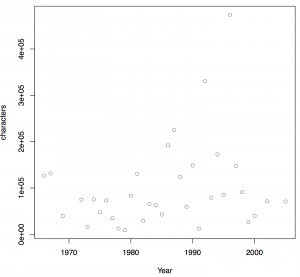 We are finally getting results in a long slow process of trying to study tool discourse in the digital humanities. Amy Dyrbe and Ryan Chartier are building a corpus of discourse around tools that includes tool reviews, articles about what people are doing with tools, web pages about tools and so on. We took the first coherent chunk and Ryan has been analyzing it with R. The graph above shows which years have the most characters. My hypothesis was that tool reviews and discourse dropped off in the 1990s as the web became more important. This seems to be wrong.
We are finally getting results in a long slow process of trying to study tool discourse in the digital humanities. Amy Dyrbe and Ryan Chartier are building a corpus of discourse around tools that includes tool reviews, articles about what people are doing with tools, web pages about tools and so on. We took the first coherent chunk and Ryan has been analyzing it with R. The graph above shows which years have the most characters. My hypothesis was that tool reviews and discourse dropped off in the 1990s as the web became more important. This seems to be wrong.
Here are the high-frequency words (with stop words removed). Note the modal verbs “can”, “will”, and “may.” They indicate the potentiality of tools.
“can” 2305
“one” 1996
“text” 1940
“word” 1931
“words” 1859
“program” 1606
“ii” 1514 (Not sure why)
“will” 1361
“language” 1307
“data” 1285
“two” 1188
“system” 1183
“computer” 1116
“used” 1115
“use” 942
“user” 939
“file” 890
“first” 870
“may” 853
“also” 837